Clinical study of robot-assisted placement of thoracolumbar pedicle screws
-
摘要:
目的 探讨天玑骨科手术机器人系统辅助下置入胸腰椎椎弓根螺钉的临床效果。 方法 将2018年8月—2020年5月于安庆市第一人民医院脊柱外科接受胸腰椎椎弓根螺钉内固定手术的40例患者,根据手术方式分为机器人辅助手术组和“C”形臂透视下徒手组,2组各20例。记录每台手术椎弓根螺钉的置入时间及术中透视次数,根据术后X线和三维CT评价2组螺钉的位置情况(准确率),评判螺钉置入的准确性和安全性。 结果 机器人辅助手术组每枚螺钉置入时间为平均(13.85±1.41)min,“C”形臂X线透视下徒手置钉组每枚螺钉置入时间为平均(14.03±1.84)min,2组数据差异无统计学意义(P>0.05)。机器人辅助手术组共置入螺钉94枚,Ⅰ级螺钉90枚,Ⅱ级螺钉4枚,Ⅲ级螺钉0枚,准确率为95.74%(90/94);“C”形臂X线透视下徒手置钉组共置入螺钉96枚,Ⅰ级螺钉83枚,Ⅱ级螺钉10枚,Ⅲ级螺钉3枚,准确率为86.46%(83/96);2组数据对比,差异有统计学意义(P<0.05)。机器人辅助手术组术中的透视次数为(8.15±1.53)次,“C”形臂X线透视下徒手置钉组术中的透视次数为(13.35±2.58)次,2组比较差异有统计学意义(P<0.01)。 结论 天玑骨科手术机器人辅助手术能明显提高置入椎弓根螺钉的准确性及安全性,同时也减少了术中放射线辐射,但并未明显增加置钉时间,在脊柱手术中有着巨大的手术潜能和优势。 Abstract:Objective To explore the clinical effect of thoracic and lumbar pedicle screw placement with the assistance of a robotic system for orthopaedic surgery. Methods Total 40 patients underwent thoracolumbar pedicle screw internal fixation at the Department of Spine Surgery, Anqing First People's Hospital From August 2018 to May 2020 were divided into two groups: robot assisted operation group and "C" arm fluoroscopy group with 20 cases in each group according to the operation methods. The placement time of each pedicle screw and the number of intraoperative fluoroscopy were recorded, and the position (accuracy) of the two groups of screws was evaluated on the basis of postoperative X-ray and three-dimensional CT. Moreover, the accuracy and safety of screw placement were evaluated. Results In the robot-assisted surgery group, the average screw insertion time was (13.85±1.41) min, and in the "C" arm X-ray fluoroscopy, the screw insertion time was (14.03±1.84) min, and the difference between the two groups of data was not statistically significant (P>0.05). A total of 94 screws were placed in the robot-assisted surgery group (90 in Class Ⅰ screws, 4 in Class Ⅱ screws and 0 in Class Ⅲ screws), with an accuracy rate of 95.74% (90/94). Using the "C" arm X-ray fluoroscopy, a total of 96 screws (83 Grade Ⅰ screws, 10 Grade Ⅱ screws and 3 Grade Ⅲ screws) were placed in the nail placement group, with an accuracy rate of 86.46%(83/96). The difference between the two groups was significant (P < 0.05). The number of fluoroscopy in the robot-assisted surgery group was (8.15±1.53) times, and the number of fluoroscopy in the "C" arm X-ray fluoroscopy was (13.35±2.58) times. The difference between the two groups was statistically significant (P < 0.05). Conclusion The robot-assisted Tianji orthopaedic surgery can improve the accuracy and safety of pedicle screw placement and reduce intraoperative radiation, but it does not significantly increase the time of nail placement. Furthermore, it has a great application potential in spinal surgery. -
Key words:
- Pedicle screw /
- Internal fixation /
- Robotics /
- Surgical procedures
-
表 1 2组置入胸腰椎椎弓根螺钉患者手术情况比较(x±s)
组别 例数 年龄
(岁)性别(例) 置钉数(枚) 置钉准确率
[枚(%)]平均每枚螺钉
置入时间(min)术中平均透视
次数(次)男性 女性 Ⅰ级螺钉 Ⅱ级螺钉 Ⅲ级螺钉 合计 机器人辅助组 20 55.40±8.20 12 8 90 4 0 94 90(95.74) 13.85±1.41 8.15±1.53 “C”型臂透视组 20 56.75±9.15 7 13 83 10 3 96 83(86.46) 14.03±1.84 13.35±2.58 统计量 0.491a 2.506b 5.834b 5.027b 0.337a 7.749a P值 0.626 0.113 0.054 0.025 0.738 <0.001 注:a为t值,b为χ2值。 -
[1] 朱如森, 冯世庆, 刘岩. 脊柱内固定椎弓根螺钉置入后生物力学的稳定性[J]. 中国组织工程研究, 2013, 17(17): 3156-3163. https://www.cnki.com.cn/Article/CJFDTOTAL-XDKF201317025.htm [2] LEE G W, SON J H, AHN M W, et al. The comparison of pedicle screw and cortical screw in posterior lumbar interbody fusion: a prospective randomized noninferiority trial[J]. Spine J, 2015, 15(7): 1519-1526. doi: 10.1016/j.spinee.2015.02.038 [3] 李彦明, 李明, 张国友, 等. 3D打印在脊柱侧凸矫形中的应用初探[J]. 第二军医大学学报, 2016, 37(02): 231-235. https://www.cnki.com.cn/Article/CJFDTOTAL-DEJD201602017.htm [4] BERTELSEN A, MELO J, SÁNCHEZ E, et al. A review of surgical robots for spinal interventions[J]. Int J Med Robot, 2013, 9(4): 407-422. doi: 10.1002/rcs.1469 [5] FOLEY K T, SIMON D A, RAMPERSAUD Y R. Virtual fluoroscopy: computer-assisted fluoroscopic navigation[J]. Spine, 2001, 26(4): 347-351. doi: 10.1097/00007632-200102150-00009 [6] 赵燕鹏, 唐佩福. 骨科机器人及导航技术研究进展[J]. 中国矫形外科杂志, 2016, 24(3): 242-246. https://www.cnki.com.cn/Article/CJFDTOTAL-ZJXS201603015.htm [7] BARZILAY Y, LIEBERGALL M, FRIDLANDER A, et al. The international journal of medical robotics and computer assisted surgery[J]. Int J Med Robot, 2006, 2(2): 146-153. doi: 10.1002/rcs.90 [8] MOLLIQAJ G, SCHATLO B, ALAID A, et al. Accuracy of robot-guided versus freehand fluoroscopy-assisted pedicle screw insertion in thoracolumbar spinal surgery[J]. Neurosurgical Focus, 2017, 42(5): E14. doi: 10.3171/2017.3.FOCUS179 [9] 翟骁, 陈自强, 杨明园, 等. 国内首次机器人辅助椎弓根螺钉置入脊柱侧凸矫形手术(附14例报告)[J]. 第二军医大学学报, 2015, 36(11): 1161-1166. https://www.cnki.com.cn/Article/CJFDTOTAL-DEJD201511002.htm [10] 刘华水, 段升军, 贾逢爽, 等. TiRobot机器人辅助经皮空心螺钉内固定治疗不稳定型骨盆骨折[J]. 山东大学学报(医学版), 2017, 55(7): 103-109. https://www.cnki.com.cn/Article/CJFDTOTAL-SDYB201707019.htm [11] 田伟, 王晋超, 刘亚军, 等, 上颈椎手术方式回顾及应用机器人辅助上颈椎手术的体会[J]. 中国医疗器械信息, 2017, 23(7): 9-13. doi: 10.3969/j.issn.1006-6586.2017.07.002 [12] 艾克帕尔·吾不利, 买买艾力·玉山. 微创脊柱内固定系统治疗无神经损伤胸腰椎骨折的临床疗效分析[J]. 中国临床研究, 2017, 30(5): 649-651. https://www.cnki.com.cn/Article/CJFDTOTAL-ZGCK201705020.htm [13] 田伟, 范明星, 韩晓光, 等. 机器人辅助与传统透视辅助脊柱椎弓根螺钉内固定的临床对比研究[J]. 骨科临床与研究杂志, 2016, 1(1): 4-10. https://www.cnki.com.cn/Article/CJFDTOTAL-GKLC201601004.htm [14] 范明星, 刘亚军, 段芳芳, 等. 机器人辅助胸腰椎椎弓根螺钉内固定术的学习曲线和临床意义[J]. 骨科临床与研究杂志, 2018, 3(4): 213-217. https://www.cnki.com.cn/Article/CJFDTOTAL-GKLC201804007.htm [15] 刘亚军, 曾成, 范明星, 等. 俯卧位机器人辅助脊柱外科手术中呼吸运动导致体椎位移评估与测量[J]. 临床军医杂志, 2016, 44(10): 1015-1018. https://www.cnki.com.cn/Article/CJFDTOTAL-JYGZ201610007.htm [16] 章仁杰, 申才良, 张华庆, 等. 骨科机器人辅助胸腰椎椎弓根螺钉内固定位置不良原因分析[J]. 颈腰痛杂志, 2019, 40(5): 577-582. doi: 10.3969/j.issn.1005-7234.2019.05.001 -





 下载:
下载:


